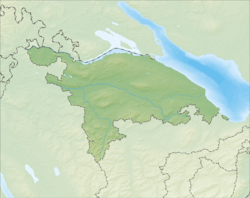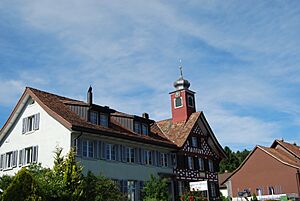Eschlikon facts for kids
Quick facts for kids
Eschlikon
|
||
|---|---|---|
 |
||
|
||
| Country | Switzerland | |
| Canton | Thurgau | |
| District | Münchwilen | |
| Area | ||
| • Total | 6.22 km2 (2.40 sq mi) | |
| Elevation | 570 m (1,870 ft) | |
| Population
(Dec 2020 )
|
||
| • Total | 4,577 | |
| • Density | 735.9/km2 (1,905.8/sq mi) | |
| Postal code |
8360
|
|
| Surrounded by | Bichelsee-Balterswil, Fischingen, Münchwilen, Sirnach, Wängi | |
Eschlikon is a small town, also called a municipality, located in the canton of Thurgau in Switzerland. It's part of the Münchwilen district.
Contents
History of Eschlikon
Eschlikon was first mentioned way back in 1280! Back then, it was called Aeslikon. During the Middle Ages (a long time ago, from about 500 AD to 1500 AD), most of Eschlikon belonged to a monastery called Magdenau and a hospital in St. Gallen.
For many years, from the late Middle Ages until 1798, Eschlikon was home to the Swiss Confederation Governor or his special helper, called a Vogt. These people were in charge of the area.
The village church was originally part of a bigger church area called a parish in Sirnach. In 1529, many people in Eschlikon changed their religion during the Protestant Reformation. This was a time when new Christian churches were formed. The people who became Protestant later formed their own church group with nearby towns like Münchwilen. The people who stayed Catholic continued to be part of the Sirnach parish.
For a long time, people in Eschlikon mainly did farming, grew grapes for wine, and dug up peat (a type of soil). In the late 1800s, raising cattle and making dairy products became very important.
Over the years, different types of textile (fabric) factories grew in the village. First, there was linen, then cotton mills opened. Between 1870 and 1930, making embroidery and knitwear was a big part of the local economy. There was even a brick factory that operated for many years.
In 1875, the town started its own bank to help people with loans and savings. However, the bank had problems in 1912, which was a difficult time for the town. From the mid-1900s, many new factories and businesses moved to Eschlikon, changing it from a small farming village into a more industrial place. For example, a metal goods factory called Spring employed 200 people.
Geography of Eschlikon
Eschlikon covers an area of about 6.21 square kilometers (about 2.4 square miles). A big part of this land, about 62.5%, is used for farming. About 18.5% of the land is covered by forests. The rest of the land, about 17.7%, has buildings or roads on it.
The town is located at the foot of a hill called Tuttwilerberg, along the road that connects Aadorf and Wil. Eschlikon is a linear village, which means it's built mostly along a road. It also includes two smaller settlements called hamlets: Wallenwil and Hurnen.
People of Eschlikon (Demographics)
Eschlikon has a population of about 3,948 people (as of 2011). About 11.9% of the people living here are from other countries. Most people in Eschlikon, about 92.8%, speak German. The next most common languages are Italian (1.9%) and Albanian (1.3%).
In 2009, about 10.7% of the population were children aged 0 to 9 years old. Teenagers, aged 10 to 19, made up about 13.0% of the population. This shows that Eschlikon has a good number of young people!
The population of Eschlikon has grown quite a bit over the years:
| year | population |
|---|---|
| 1850 | 422 |
| 1900 | 640 |
| 1950 | 1,026 |
| 1990 | 1,814 |
| 2000 | 3,133 |
| 2004 | 3,456 |
| 2011 | 3,948 |
Sights to See
Eschlikon has a Catholic church that was built in 1963. Inside, you can see two beautiful stained glass windows made by an artist named Yoki Aebischer in 1964.
Economy and Jobs
In 2005, there were 46 people working in the primary economic sector. This means they worked in things like farming or forestry. About 524 people worked in the secondary sector, which includes manufacturing and factories. The largest group, 494 people, worked in the tertiary sector, which covers services like shops, schools, and offices.
Many people who live in Eschlikon also travel to other towns for work. In 2000, about 51.3% of the people living in Eschlikon worked outside the town. About 14.4% of workers used public transportation to get to their jobs, while 51.9% used a private car.
Religion in Eschlikon
According to a census in 2000, about 38.6% of the people in Eschlikon were Roman Catholic. About 40.9% belonged to the Swiss Reformed Church, which is a Protestant church. There were also smaller groups of people who belonged to other Christian churches, the Muslim faith, or no church at all.
Weather in Eschlikon
Eschlikon usually has about 140.8 days of rain or snow each year. On average, it gets about 1268 millimeters (about 50 inches) of rain or snow annually. The wettest month is June, with about 135 millimeters (about 5.3 inches) of rain or snow. The driest month is October.
Education
In Switzerland, most people are well-educated. In Eschlikon, about 75.9% of adults (between 25 and 64 years old) have finished high school or gone on to higher education, like a university.
See also
 In Spanish: Eschlikon para niños
In Spanish: Eschlikon para niños






